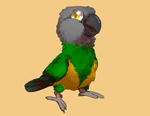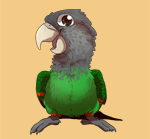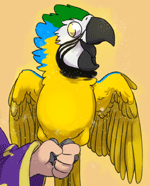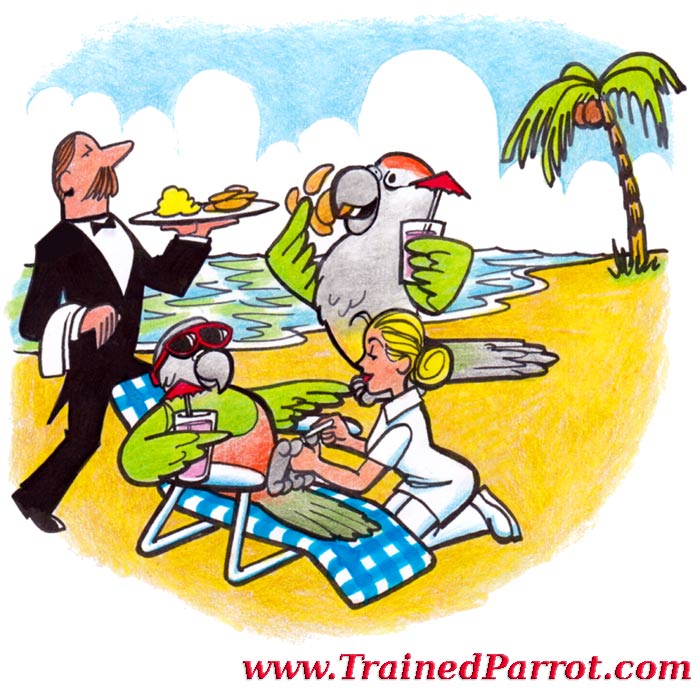 Kili
Type: Senegal Parrot
Genus: Poicephalus
Species: Senegalus
Subspecies: Mesotypus
Sex: Female
Weight: 120 grams
Height: 9 inches
Age: 15 years, 10 months
|
 Truman
Type: Cape Parrot
Genus: Poicephalus
Species:Robustus
Subspecies: Fuscicollis
Sex: Male
Weight: 330 grams
Height: 13 inches
Age: 14 years, 1 month
|
 Rachel
Type: Blue & Gold Macaw
Genus: Ara
Species:ararauna
Sex: Female
Weight: 850 grams
Height: 26 inches
Age: 11 years, 10 months
|
List of Common Parrots:
Parakeets:
Budgerigar (Budgie)
Alexandrine Parakeet
African Ringneck
Indian Ringneck
Monk Parakeet (Quaker Parrot)
Parrotlets:
Mexican Parrotlet
Green Rumped Parrotlet
Blue Winged Parrotlet
Spectacled Parrotlet
Dusky Billed Parrotlet
Pacific Parrotlet
Yellow Faced Parrotlet
Lovebirds:
Peach Faced Lovebird
Masked Lovebird
Fischer's Lovebird
Lilian's (Nyasa) Lovebird
Black Cheeked Lovebird
Madagascar Lovebird
Abyssinian Lovebird
Red Faced Lovebird
Swindern's Lovebird
Lories and Lorikeets:
Rainbow Lorikeet
Conures:
Sun Conure
Jenday Conure
Cherry Headed Conure
Blue Crowned Conure
Mitred Conure
Patagonian Conure
Green Cheeked Conure
Nanday Conure
Caiques:
Black Headed Caique
White Bellied Caique
Poicephalus Parrots:
Senegal Parrot
Meyer's Parrot
Red Bellied Parrot
Brown Headed Parrot
Jardine's Parrot
Cape Parrot
Ruppell's Parrot
Eclectus:
Eclectus Parrot
African Greys:
Congo African Grey (CAG)
Timneh African Grey (TAG)
Amazons:
Blue Fronted Amazon
Yellow Naped Amazon
Yellow Headed Amazon
Orange Winged Amazon
Yellow Crowned Amazon
Cockatoos:
Cockatiel
Galah (Rose Breasted) Cockatoo
Sulphur Crested Cockatoo
Umbrella Cockatoo
Moluccan Cockatoo
Bare Eyed Cockatoo
Goffin's Cockatoo
Macaws:
Red Shouldered (Hahn's) Macaw
Severe Macaw
Blue And Gold Macaw
Blue Throated Macaw
Military Macaw
Red Fronted Macaw
Scarlet Macaw
Green Winged Macaw
Hyacinth Macaw
Glossary of Common Parrot Terms
|
| | Thursday December 22nd, 2011 |
|
I get often asked about leaving parrots home while going on vacation. Well this article is about how going away on vacation ends up being a vacation for the parrots as well! There are many reasons we can't bring our feathered friends with us whether its safety, accommodations, going abroad, or just needing to get away from the squawking and cleaning for a little bit. So this article is about making your absence tolerable for your parrots.
The first and definitely most important thing for preparing your parrots for your absence is getting them used to being without you beforehand. When we hear of stories of an owner leaving a parrot home a week to come back and find it plucked naked, often this is a result of the parrot being completely spoiled with attention and then suddenly deserted. But just like taming, independence also takes some getting used to for our feathered pals. Even if you don't see yourself going on vacation any time soon, it is still important to maintain a controlled relationship. What if someone in your family becomes ill and needs care? What if you get sent some place for work? There are many unexpected scenarios besides just taking a vacation that may require our parrots to cope without our presence. The only way to prepare them for this is by letting them experience this beforehand.

Your parrot needs to be just as capable of spending time alone as with you. Surely many of us are more concerned with taming and getting them to behave with us, but we must not take this too far and make them entirely dependent on us either. This is why (both for training and vacation purposes) I recommend limited out of cage and interaction time daily. There are minimums and they are much discussed, but I also believe there should be maximums. It's impossible to put exact numbers on it but the point is that your parrot needs to spend enough time in its cage on its own every day that it won't entirely freak out when suddenly you aren't around a day.
It is important to provide good cage enrichment and activities. Of course this is much discussed elsewhere and is a good practice all the time. While maintaining routine is convenient and reassuring, it's important to be spontaneous from time to time. Yes, I try to be home to see my parrots on time, feed them at the normal time, etc. But once in a while if I need to be out late or decide to put them to sleep late than usual, it just prepares them for dealing with out of the ordinary scenarios. If I actually end up going a very long time without a natural break in the routine, I may opt to not take them out a certain day despite being home just to simulate this. But normally there are real reasons for this to happen so I generally save it for these occasions.
Don't be scared to leave the parrots home for an entire day or weekend (preferably with someone to keep an eye on them). If you've never done it before, be sure to see how they do a weekend without your presence prior to leaving them for an entire week or more. Try progressively longer durations. If you are leaving the birds alone for 12-48 hours without anyone to check up on them, consider leaving multiple sources of food and water in case any are spoiled or contaminated. A water bottle is preferable. Never leave parrots completely unattended for more than 2 days at a time though because if anything does happen to their food/water supply, they won't be able to make it much longer than this without intervention.
A question that frequently comes up is if it is better to leave parrots at home and have someone come to take care or to bring them along with their cages to someone else's home. Unless it cannot be arranged, I think it is much better and safer for the parrots to stay home. Not only are they familiar at home but they will also feel safer. To take both their favorite person away and the familiarity of their surroundings is more stressful. People worry that they'll get bored without people around, but I think if you make the above mentioned preparations they will be equipped to deal with it. Another thing is that the parrots are significantly safer remaining in your own home. As a parrot owner, you've probably spent years making your home bird safe. It is easy to begin to take this for granted and forget dangers they could face in someone else's home such as teflon fumes, other pets, children, ceiling fans, windows, etc. For all these reasons, it is best to have a sitter come briefly to your home to care for the parrots each day rather than take the birds to their own home.
When having someone birdsit for you, one of the most important considerations is whether or not they will handle the parrots. In most cases, unless the person is both familiar with parrots and specifically familiar with handling yours, it is safer not to have them let the parrots out. As much as it sucks to stay in the cage for two weeks straight, it is safer than being let loose in your home by someone who can't put them back away. Still, discuss a contingency plan with the birdsitter about what to do if they get out and cannot be returned to their cage. The sitter should leave the cage doors open and cage loaded with food so that the parrot can eventually go back inside to feed.
When I am away, I like to leave my parrots more toys than usual to keep them busy. I put in several new toys to provide with more activity and material for the parrots to play with. However, I also like to leave a few old favorite toys for familiarity as well. I make sure not to rearrange the perches just before leaving instead favoring a tried and true cage layout. This is not the time to experiment with new kinds of toys though, so any new toys that are provided should be similar to safe/successful toys in the past.
I usually end up writing a basic manual covering all things that need to be taken care of and possible contingencies for my bird sitter. So not only do I tell about the basic things that need to be done but also what to do in case there are problems and I cannot be reached. This includes biting, escape, illness, vet care, etc. At the same time, I try to reduce unnecessary activities by as much as possible not to burden the sitter too much.
The birds are fed exclusively pellets while I'm gone. Why? This is safest, simplest, and most nutritious. This is the least burden but also least responsibility for the care taker. The parrots are guaranteed to get all the nutrition they require, the food won't spoil, and it's very easy to guarantee that they don't run out of food in any way. Although I normally follow strict food management, I have my birds overfed while I'm gone. A normal pellet meal won't even line the entire bottom of their food bowls but when I'm gone I have the bowls nearly topped off. I make sure the birds are left with enough food to last several days despite the sitter coming daily. This is to ensure that if for any reason the sitter skips a day, the birds have enough food and water to get by. While we are concerned about long term diet and variety in their meals, a 100% unlimited pellet diet for a few weeks won't do any harm for a parrot that is accustomed to eating pellets.

 Aritos, Latin American Onion Ring Parrot Chips (Ara + Fritos = Aritos?) Aritos, Latin American Onion Ring Parrot Chips (Ara + Fritos = Aritos?)
Finally, the reason I called this parrot vacation is because if done right, this can be as much of a relaxing vacation for your parrots as it is for you. Recently I spent a week traveling in Central America while my brother came once a day to take care of Kili and Truman. He is fully qualified to handle them so he would let them out for as much as an hour every day to fly around. They couldn't be more thrilled! I came back to find they had assumed full control of the situation! My computer mouse was destroyed, poop all over the carpets, and the birds helping themselves to places I would never allow them to go. Not only this, but they stuffed their crops to the brink for every day nonstop. No discipline, no food management, no responsibility. It truly was a vacation for them as well. But this is ok. Let them have it easy while you're gone and then work the taming, training, and order back in once you return.
So with all the preparations that were made over time, it was no trouble at all to leave the parrots home for a week. I got to take a vacation and do some traveling. Meanwhile Kili & Truman also got to take a vacation from training and just enjoy being wild for a little bit. |
Find out about how to train tricks and good behavior to your parrotHow to teach my parrot tricks, how to teach my parrot to step up, how to train my parrot to fly to me
Senegal Parrot, Cockatiel, Budgerigar, Parakeet, Conure, Poicephalus Parrots, African Grey Parrot, Eclectus, Amazon, Cockatoo, Macaw
Thank you for visiting the parrot training blog trainedparrot.com. The website will be up soon but in the meantime please visit the parrot forum.
This is a blog about how I trained my Senegal Parrot but it is relevant to training any kind of parrot
People often ask me how I trained my parrot but unfortunately I do not have videos of the early training sessions with Kili. So now that I am getting a new Cape Parrot, I intend to record videos and write articles about it from the very beginning
This parrot blog has been created to discuss, display, post about and talk about how to teach and tame parrots. This blog will show experiences in methods of how to train a parakeet a trick. This blog will also reveal experiences with how to tame and bond with a Senegal Parrot. Experiences training an African Grey to talk on cue will be discussed on this blog. This blog will show that parrots are incredibly entertaining and fascinating animals that can bring a lot of joy to their owner's lives. Owning one may involve training tricks, taming, bonding, and caring for these intelligent animals. Although parrots are extremely enjoyable companion pets, this blog will show that they do have downsides. Parrots love to chew, and they will make a mess. Many parrots have are aggressive or scared. Some parrots will bite, lunge, screech, scream and fly away out of aggression, to defend their territory, or out of fear. Problems can be overlooked or overcome if you teach, train and tame a parrot with the correct techniques used by contributors of this blog.
For anyone who is considering a parrot as a pet, a considerable amount of research and evaluation should be done before a decision is made. Some companion bird species can outlive their owner. An Eclectus may live for 65 years, an Amazon has a life expectancy of about 50 years, a Macaw may reach the age of 60 years, Budgies can live to be about 20 years old, and some Cockatoos can live to be about 65 years old but a Cockatiel may live for 20 years. As a result of such a long lifespan in many species, a parrot should be a lifetime commitment. You must imagine yourself later into your life and consider if you would still be willing to care for your pet decades from now.
This blog will depict a log of experiences of parrot owners who teach their parrots how to perform a trick and the process involved to train one to mimic an entertaining word, phrase, or sound. Some basic tricks to teach a parakeet how to perform are wave, shake, nod, spin or turn around, and show or lift and spread wings. This blog will depict experiences with target or stick training, using a clicker, and this blog will depict experiences with how to use this technique and a clicker to train tricks. Teaching tricks shown on this blog is an incredibly fun and enjoyable way to bond with your parrot. Target or stick train and clicker techniues apply to parrots of all sizes, including a parakeet, a parrotlet, a lovebird, a lorikeet, a caique, a senegal parrot, a meyer's parrot, a red bellied parrrot, an eclectus parrot, an african grey parrot, an amazon, a cockatiel, a cockatoo, and a macaw.
Many parrots are chosen for specific desired qualities that generally occur in that type. Amazon parrots are bold, friendly and confident talking parrots and they can learn to sing songs. African Grey parrots are known to be one the best and clearest talkers. Cockatoos are extremely cuddly, playful and affectionate but demanding birds. Macaws are large, brightly colored and loving parrots with the potential for a very big bite. Poicephalus parrots are small, quiet birds with a bigger bird type of personality. Conures are parakeets with some varieties having extremely beautiful plumage but they are known to be loud. Budgerigars, parrotlets, and lovebirds are small, inexpensive and widely available parrots with many beautiful genetic mutations.
Blog Frequently Asked Questions
How do I get my Alexandrine parakeet to step up?
Training a bird to step up is a universal technique that can be applied to a parakeet, as well as a macaw, grey, cockatoo, amazon, conure, poicephalus, lovebird, parrotlet, caique, and more. In order to teach your parakeet how to step up, you must think of a command you would like to use to cue your Alexandrine parakeet when you would like it to step up. You can choose to say something such as "Up", "Step Up" or "Hop Up" and always use it as your cue. To teach your parakeet how to step up, you simply hold your finger out under your Alexandrine parakeet's abdomen, press it gently against your Alexandrine parakeet, and your bird will become unbalanced. In order to correct its balance, it will step forward and up onto your finger. To make this training effective and rewarding, always reward your parakeet with praise each time they step up onto your finger. Saying "good" or "good bird" and giving your parakeet attention when they step up will teach your parakeet that if they step up onto your finger, they will enjoy it.
What are the essential items needed to own for an Amazon parrot? What supplies do I need to buy from a pet supplies store when I purchase my Amazon parrot?
The Amazon parrot is a large sized parrot and needs an appropriately large sized cage. Your Amazon parrot should be able to move around a bit inside of its cage, as well as have room to stretch its wings completely. A cage for an Amazon would most likely also be appropriate for an African Grey, a Cockatoo, an Ecelctus, and possibly a Macaw. You will need to make sure that the spacing between the bars of your cage is appropriately sized for your bird. Your Amazon should not be able to stick its head through the bars of the cage because that is a safety hazard for a parrot and it is extremely dangerous. Some pet supplies store items that are essential for owning an Amazon are a variety of types of parrot toys, a variety of natural wood perches, food bowls, a water bottle, a cuttle bone or mineral block, food, treats, and vitamins. In addition, you should purchase a book about owning your Amazon, a carrier for traveling, and supplies to clean your Amazon parrot's cage.
How do I stop my Sun Conure from screaming when I leave the room?
The Jenday Conure, the Nanday Conure, and the Sun Conure are known to be very loud. If your Sun Conure has learned to scream for you whenever you leave and you responded to the scream by giving it attention instead of leaving, it has learned to scream to get your attention. In order to get your Conure to stop screaming for attention, all you can do is simply ignore the behavior. Never respond to your Conure screaming whenever you leave and your Conure will figure out on its own that screaming is a waste of effort and time. It may take a while to undo all the reinforcing you have made to the screaming and your Conure may have screaming fits for days or weeks before it learns to stop trying, but you cannot be sympathetic to the screaming.
Why do you need to weigh your Blue and Gold Macaw on a scale?
It is important to weigh your Blue and Yellow Macaw on a gram scale because Macaws, like all parrots, hide illnesses. You may not realize that your Blue and Yellow Macaw is ill you have weighed it on a scale and noticed that your bird is underweight. Being underweight may be a sign of a disease of some kind such as a bacterial crop infection, a virus or another kind sickness. A large gram scale may be needed with a perch on it to weigh large species of Macaws. It is important to continually weigh your Macaw and find out your Macaw's average weight based on its normal fluctuations and watch for this seemingly unnoticed symptom. If you notice that your Blue and Gold Macaw continues to have a very low weight or is losing weight dramatically, it is important to take your bird to a veterinarian immediately for an examination and treatment.
Should I clip my Senegal Parrot's wings?
Clipping your Senegal parrot's wings has many downsides. If your clipped Senegal parrrot falls, it may not be able to catch its own fall and it may suffer from an injury. A poicephalus parrot without flight feathers would be very vulnerable to a serious injury from a hard fall. If your clipped Poicephalus parrot molts in new feathers, the new primary feathers will stick out. As the new flight feathers molt in and they are developing, they may break. If a blood feather breaks, your Senegal parrot may suffer from a tremendous amount of bleeding. These problems can be avoided by not clipping your Senegal Parrot's wings. All poicephalus parrots can benefit from being flighted, including the Meyer's Parrot, the Red Bellied Parrot, the Brown Headed Parrot, the Jardine's Parrot, the Cape Parrot, and the Rüppell's Parrot.
How do you target train your Congo African Grey parrot?
Target training is a fundamental skill your parrot should learn. To begin to teach or train your African Grey parrot how to target, you should obtain an unused, untoxic chop stick. Hold the stick out in front of your Africa Grey parrot in the hopes that they might bite the very tip of the chop stick. If they touch it at all, even by accident, click your clicker and reward them with a treat. If they are not interested, you may have to force them by touching the stick to their beak and rewarding them. Always reward for them touching the end of the stick. Always wait for them to touch the stick or take it away out of their sight, wait a minute, and then try again with an easier distance. Be sure to vary the distance and the direction as much as you possibly can. Targeting is the most useful behavior to teach an African Grey or any other species because it can be used to teach your African Grey to perform a trick or follow the target stick where you want your parrot to go.
How do you stop a Lovebird from biting you?
It is impossible to stop your Lovebird from biting. Start teaching your Lovebird to behave the way you'd like it to by never reacting to any of the bites your Lovebird is giving you. Do not ever try to punish your bird, yell at your bird, or put your Lovebird away as a result of a bite. You must ignore a bite at all times to prevent bites from being reinforced. Luckily, lovebirds have a small beak and they cannot bite very hard. Similarly, Budgies, Parrotlets, Cockatiels, and Parakeets have very small beaks and very weak bites. However, you can distract your Lovebird when it is biting you in several ways. You can misbalance your Lovebird if it is perched on you, you can cue your bird to do a trick and you can make your bird step up onto your fingers repeatedly to tire your bird. If you train your Lovebird to perform a trick, it will most likely try to do a trick to earn a treat instead of trying to bite you. If you teach your bird how to target to a chopstick, you will have an effective hands off method of handling your Lovebird. In addition, your Lovebird will have a positive association with you if you are giving it a reward. These tips can be applied to all other species of parrots regardless of size in avoiding and preventing bites or any aggressive behavior.
Is it safe to have nonstick pans if I own a Parrotlet or are they dangerous and toxic to birds?
The fumes given off from overheating the nonstick coating on nonstick pans is toxic and fatal to a Parrotlet, Lovebird, Budgie, Parakeet, Conure, Cockatiel, Caique, Poicephalus, Eclectus, Grey, Amazon, Cockatoo, Macaw and all other parrots. You should immediately dispose of and purchase an alternative to your nonstick pans. People think that nonstick pans are safe to keep as long as they are not overheated, but this is not true and too risky for the safety of your Parrotlet. You can use affordable alternatives to your nonstick pans such as stainless steel pans and cast iron pans which do not give off toxic fumes.
Is it safe to have a pet cat or dog along with my Budgies?
Cats and dogs are predatory, meat eating animals who they can and most likely will injure, kill and consume your Budgies. It is extremely unsafe to own a cat or a dog with any kind of parrot because there is an extreme risk that a cat or a dog would get into your their cage and harm your bird if you are not there to watch your pets all of the time. A cat or a dog would also be dangerous to keep around larger parrots that they may not be capable of eating such as the African Grey, Cockatoo, Amazon, and Macaw because of bacteria present in cat and dog saliva. This bacteria could cause a fatal blood infection in your Budgies. |
|



 Aritos, Latin American Onion Ring Parrot Chips (Ara + Fritos = Aritos?)
Aritos, Latin American Onion Ring Parrot Chips (Ara + Fritos = Aritos?) Older Articles
Older Articles  Newer Articles
Newer Articles